List of World War I memorials and cemeteries in Champagne-Ardennes
This is the List of World War I memorials and cemeteries in Champagne-Ardennes.
The modern-day Champagne-Ardenne, bordering Belgium in northeast France, covers four departments: Aube, Ardennes, Haute-Marne, and Marne. This region saw much fighting in World War I (1914–1918) and many battles, of which arguably the most important were the First Battle of the Marne and the Second Battle of the Marne. The First Battle of the Marne, also known as the Miracle of the Marne, was fought between 5 and 12 September 1914. The battle effectively ended the month-long German offensive that had opened the war and the counterattack of six French field armies and the British Expeditionary Force (BEF) along the Marne River forced the German Imperial Army to abandon its push on Paris and retreat northeast to the Aisne river, setting the stage for four years of trench warfare on the Western Front
The Second Battle of the Marne (a.k.a. the Battle of Reims), fought from 15 July to 6 August 1918, was the last major German attack of their five-phase Spring Offensive. The German attack failed when an Allied counterattack led by French forces and including several hundred tanks overwhelmed the Germans on their right flank, inflicting severe casualties. The German defeat marked the start of the relentless Allied advance of the Hundred Days Offensive which culminated in the Armistice.
Needing to come to terms with the loss of so many lives in the conflict, particularly those whose remains went unidentified, war memorials – known in France as monuments aux morts, literally "monuments to the dead" – became a focal point and replaced individual graves and gravestones. Between 1919 and 1926, many thousands of memorials were erected throughout France, including large national monuments, civic memorials, war cemeteries, private memorials, halls and parks. Ceremonies are often held at the memorials, including those on Armistice Day and the Fêtes de la Victoire.
Battles of the Marne
Memorial to the First Battle of the Marne at Mondemont
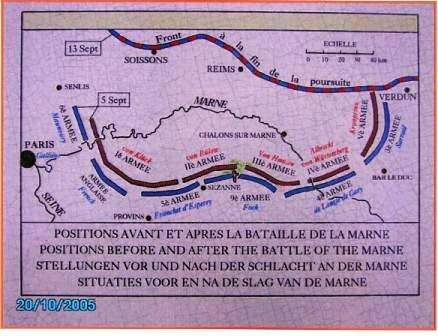
| Memorial to the First Battle of the Marne at Mondemont |
|---|
| The memorial at Mondemont commemorates the First Battle of the Marne, fought from 5 to 12 September 1914. Its location is on the site of the Château de Mondement, south of the marshes of St Gond. On 6 September 1917, President of the Republic Raymond Poincaré held a ceremony here to commemorate the third anniversary of the battle. The French parliament subsequently voted Mondemont as the preferred site for the memorial.
In 1929, the Beaux-Arts administration organised a competition to select a suitable design for the memorial. Eventually, the commission went to the architect Paul Bigot who proposed Henri Bouchard for the main sculptural work. The monument was to take the form of a huge column to symbolise the significance of the German advance being halted, and at the top there would be a sculpture in relief of an "Angel of Victory" which would be assigned to Bouchard while bas-reliefs at the base would be assigned to established sculptors Alfred Bottiau, Albert Patrisse and René André Duparc. In December 1933, the monument was completed, but there had been difficulty in raising funds to complete the sculpture. The monument remained covered in scaffolding until 1938 when its sculptural work was completed. The inauguration was set for 19 September 1939, but the outbreak of World War II delayed this until 23 September 1951. The monument rises to a height of 35.5 metres (116 ft) and its concrete is pink in colour. The whole monument with its metal base and deep foundations weighed 2000 tonnes. The monument's scale evokes both power and defiance, as the designer had intended. At the base, bas-reliefs featured depictions of all the main Generals involved in the battle, with Joseph Joffre in the centre, his arm around a French soldier. Around him, Joffre's generals are positioned in the geographical order (from Verdun to Senlis) that they held in the battle. From left to right they are Generals Sarrail (Third Army), Langle de Cary (Fourth Army), Foch (Ninth Army), Franchet d'Espèrey (Fifth Army), Field Marshal French (BEF), Manoury (Sixth Army) and Gallieni (The Army of Paris). There are two main inscriptions on the column:and the second features Joffre's "Order of the Day" of 6 September 1914:
Other inscriptions cover the make-up of the different armies that were involved in the Allied formation and each face to the point where they were positioned at the start of the offensive. These were:
Below each of these are listed the different Corps involved. There is one final inscription which strikes a philosophical note:
During the occupation from 1940 to 1944, the Germans left the monument untouched. The local people call it the "Carrot". At the top of the monument a Celtic harp faces east and the winged statue of Victory flies from east to west through thunder, lightning and battle trumpets with the words:
|
Some images from Mondemont
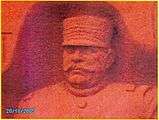 The head of Joffre carved into the Mondement column.
The head of Joffre carved into the Mondement column. Top of the column with Bouchard's "Victory Angel"
Top of the column with Bouchard's "Victory Angel" Joffre with French soldier surrounded by his Generals as carved at the base of the Mondemont memorial.
Joffre with French soldier surrounded by his Generals as carved at the base of the Mondemont memorial. The column at Mondemont.
The column at Mondemont.
Memorial to the Battles of the Marne at Dormans
| Memorial to the Battles of the Marne at Dormans |
|---|
| The memorial at Dormans commemorates both Battles of the Marne. The memorial lies in the wooded park belonging to the Chateau of Dormans. There is a chapel, a crypt and an ossuary. The stained glass windows in the chapel are the work of the Chartres firm of Lorin and the sculptures are by Firmin-Marcelin Michelet (1875–1951).
Next to the chapel is a covered area and on the walls are recorded the names of the various regiments that were involved in both battles, and relief carvings of Joseph Joffre and Ferdinand Foch, Allied Army leaders of the 1914 and 1918 battles, respectively. Their achievements are recorded, stressing the significance of the battles.[2]  Memorial Chapel and Lantern at Dormans |
Memorial to the Second Battle of the Marne at the Butte de Chalmont
| Memorial to the Second Battle of the Marne at the Butte de Chalmont |
|---|
| Dedicated to the victory at the Second Battle of the Marne, the national memorial at the Butte de Chalmont was inaugurated on 21 July 1935 by President Lebrun. It is the work of sculptor Paul Landowski and is considered to be one of the most striking monuments on the Western Front. The memorial is on the east face of the hill (butte), which was part of the plateau from which the Allies launched their counter-attack.
On the lower slope of the hill is a sculpture of a woman in a simple cloak carrying a shield on her left arm; she represents France and is walking forward and looking to the east. Behind her, are four long steps, representing the four years of the 1914–1918 war. These lead some 150 yards up the slope to the sculpture les fantômes. Its eight figures represent a young recruit, an engineer, a machine-gunner, a grenadier, a colonial soldier, an infantryman and a pilot, surrounding death who is leaving his shroud. The figures have their eyes closed; they are seeking their missing comrades. To the left and right of the memorial are two carved stone tablets. That on the left records the events of the battle and that on the right lists the Allied Generals who took part in the battle under Commander in Chief of the Allied Armies, Ferdinand Foch. The stone tablet on the left reads
|
Memorials to the Missing
These battles involved the deaths of many men and there are two major British "Memorials to the Missing" for the men lost whose remains could not be identified. The memorials at La Ferté-sous-Jouarre links to the First Battle of the Marne, and that at Soissons which links to the 1918 battle.
La Ferté-sous-Jouarre memorial
| La Ferté-sous-Jouarre memorial |
|---|
The La Ferté-sous-Jouarre memorial is located on the south bank of the River Marne, on the outskirts of the commune of La Ferté-sous-Jouarre, 66 kilometres (41 mi) east of Paris, in the department of Seine-et-Marne. Also known as the Memorial to the Missing of the Marne, it commemorates those British and Irish soldiers who have no known grave and who fell in battle in this area in August, September and early October 1914. These soldiers were part of the British Expeditionary Force (BEF), and are listed on the memorial by regiment, rank and name. The memorial itself is a rectangular block of white stone, 19 metres by 9 metres and 7 metres high (62 ft by 30 ft and 24 ft high), surmounted by a large stone sarcophagus with a flag, bayonets and a helmet. The year "1914" is carved below the sarcophagus. The two shorter sides of the memorial bear a carving of a downwards-pointing sword, while the front and back of the memorial are carved with inscriptions on panels surmounted by a carved wreath and crown. The inscription on the river-facing side is in French, while the inscription on the opposite side is in English. The memorial is mounted on a stepped stone pavement, at the four corners of which are stone pillars, carved with the coats of arms of the British Empire and topped by stone urns. At the front of the memorial's pavement is a stone of remembrance inscribed with the words: "Their name liveth for evermore." The memorial's inscription (English) reads:
The La Ferté-sous-Jouarre memorial was unveiled on 4 November 1928. The English and French military officers present at the dedication ceremony included Ferdinand Foch, Maxime Weygand, George Milne and William Pulteney Pulteney. The ceremony also commemorated the contributions of Joseph Joffre, John French, and Michel-Joseph Maunoury, the commanders of the armies who had fought in the area.[4] Near the main memorial at La Ferté-sous-Jouarre, and on each bank of the river and on either side of the nearby bridge, are two identical memorials commemorating the efforts of Royal Engineers who built, while under fire from the Germans, a floating bridge at this location in 1914.[5] The memorial was designed by George H. Goldsmith, a decorated veteran of the Western Front. The sculptor has not been identified, but much has been written about the fact that a tin helmet was wrongly included in the sculpture given that the tin helmet was not worn in 1914 and was not then standard issue.[6]  La Ferté-sous-Jouarre memorial |
Memorial to the Missing at Soissons
| Memorial to the Missing at Soissons |
|---|
The Memorial to the Missing at Soissons commemorates those officers and men of the United Kingdom forces who died during the Battles of the Aisne and the Marne in 1918 and who have no known grave. The memorial was designed by G H Holt and V O Rees and has sculptural work by Eric Kennington. The memorial was unveiled by Lt. Gen. Hamilton-Gordon in July 1928. The names of those commemorated are recorded on the panels at the rear of the memorial.
The memorial bears the inscription:
[7] The three servicemen who are the central feature of Eric Kennington's composition |
Monuments in Reims and the surrounding area
Reims was a front-line city throughout the four years of the war and suffered bombardment from German artillery. The Reims Cathedral was bombed and damaged on many occasions, and images of it became a rallying icon in the non-German world. Sixty percent of Reims was destroyed during the 1914–1918 war, and 4,567 Reims men were killed in the conflict, with a further 740 civilian casualties.
The monument aux morts in Reims
| The monument aux morts in Reims |
|---|
The war memorial in Reims is located in the Place de la République. The architect was Henri Royer with sculptural work by Paul Lefèbvre. It was inaugurated in 1930 by Philippe Pétain and the Minister of War André Maginot. The central statue in bronze shows a youth deep in thought.
There are reliefs on either side of this central figure. The relief on the left is entitled "1914 le sacrifice" and is dedicated to the families of the dead ("Aux familles des morts pour exalter la grandeur de leur sacrifice.") while that on the right bears the legend "1918 la leçon du passé" and speaks to future generations reminding them not to forget the sacrifices of their parents ("Aux generations nouvelles pour qu'elles sachent et se souviennent"). A list of the names of the dead was sealed up with one of the memorial's bricks and there is a book in the Reims town hall which also contains this information. Along the top is the inscription:[8] The statue at the centre of the Reims monument aux morts. A youth is deep in thought. |
The Monument aux infirmières de Reims
| The Monument aux infirmières de Reims |
|---|
Reims is the location of a monument dedicated to nurses from France and overseas who lost their lives serving in the war. The monument "à la gloire des infirmières françaises et alliées victimes de leur dévouement" was financed by international subscriptions organised by a committee founded and run by Juliette Adam. The architect was Charles Girault and the sculptural work is by Denys Puech. The inauguration took place on 11 November 1924, and amongst those assembled for the ceremony were Cardinal Luçon (the Archbishop of Reims), Pastor Gonin, Rabbi Hermann and General Pau.[9]
 Monument in Reims dedicated to the nurses both French and from overseas who served in the Great War and lost their lives while nursing |
Monument to the 132nd and 332nd French Infantry Regiments plus the 46th Territorials
| Monument to the 132nd and 332nd French Infantry Regiments plus the 46th Territorials |
|---|
The monument to the 132nd and 332nd French Infantry Regiment plus the 46th Territorials features a sculpture of a French soldier (poilu). It was part of the scheme to reconstruct Reims after the war, initiated by the architects Hippolyte Portevin and Max Sainsaulieu. The actual monument was the design of the architect Émile Fanjat and was funded by subscriptions raised by the veterans of the 132nd in particular, to honour the men who were killed fighting in the Éparges between 23 October 1914 and 12 April 1915. The inscription on the monument reads
The soldier on the top of the monument is the work of Paul Lefèbvre who worked on the Reims monument aux morts.[10] Monument to the 132nd French Infantry Regiment in Reims. |
Monuments to the 24th, 28th, 133rd and 363rd French Infantry Regiments at Loivre
| Monuments to the 24th, 28th, 133rd and 363th French Infantry Regiments at Loivre |
|---|
| At Loivre, to the north of Reims, there are several regimental monuments. That shown here was dedicated to the 363rd and was unveiled on 24 August 1930. The sculptor was Antoine Sartorio who had served with the 363rd himself. The monument lists the 363rd's battle honours: Vosges, Somme, Aisne, Alsace, Argonne and Champagne.
The monument to the 24th, 28th and 133rd was inaugurated on 14 October 1923. This monument has deteriorated over the years, and a number of the inscriptions are now no longer legible.[11] |
The German Cemetery at Loivre
The German cemetery at Loivre contains the remains of 4,149 men of whom 1,913 could not be identified and their remains are in an ossuary. [12]
The Monument to the 119th and 319th French Infantry Regiments and the 20th Territorials at Cauroy-lès-Hermonville
This monument is located at Cauroy-lès-Hermonville near Reims. Many men of the 119th had fallen in the Battle of Charleroi on 22 August 1914, one of the battles fought at the beginning of the war and known as the Battles of the Frontiers. One inscription is from Belgium and pays homage to the men of the 119th (aux frères – their brothers in arms)[13]
British cemetery at Hermonville

Chemin des Dames
The Chemin des Dames (literally, "path of ladies") runs 30 kilometres (19 mi) along a ridge between the valleys of the rivers Aisne and Ailette in the département of Aisne. After their retreat from the Marne, it was a logical place for the German Army to choose to turn and attempt to check the Allied advances. The German army held the ridge for most of the war, but the French made numerous attempts to remove them from it; this resulted in an enormous loss of life. 20–40 metres (66–131 ft) beneath the ridge is an almost 1 square kilometre (0.39 sq mi) cave network called "The Dragon's Lair" (La Caverne du Dragon). The subterranean caverns were originally a tunnel system created from excavations of limestone for building purposes in the 17th century, and during the war they were used by both French and German forces for field hospitals and command posts.
The Chemin des Dames has along its length many visible reminders of the war. The Fort of Malmaison held a strategic position and at La Royere the part which colonial troops played in the war is recorded. At Cerny-en-Laonnois, a little chapel is the official remembrance site for the Chemin des Dames. The Caverne du Dragon Museum is on the spot where the Germans used the old quarry as an underground barracks. The Monument to the Basques is in memory of the 36th Division, most of whom were from the south-west of France. The Plateau de Californie affords views of the Aisne valley, and was the scene of the offensive launched by General Nivelle on 16 April 1917. The village of Craonne, rebuilt in the 1920s, has the Arboretum de Craonne memorial and the National Tank Monument. All these memorials are interspersed with cemeteries and smaller monuments to the dead.
Over 130,000 men lost their lives in this area. In the French, German, British and Italian cemeteries only half of the men who died could be identified, and many were laid to rest in ossuaries.
While there were always almost daily skirmishes along the Chemin des Dames during the war there were three major battles fought. These were:
- First Battle of the Aisne (1914) – The Anglo-French counter-offensive following the First Battle of the Marne.
- Second Battle of the Aisne (1917) – Part of the Nivelle Offensive.
- Third Battle of the Aisne (1918) – The third phase (Operation Blücher) of the German Spring Offensive.
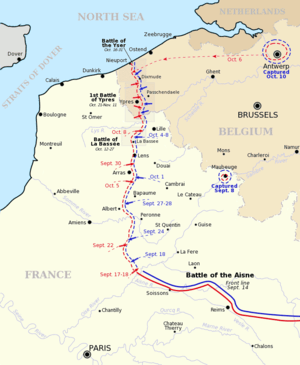
The First Battle of the Aisne was the Allied follow-up offensive against the right wing of the German First Army (led by Alexander von Kluck) and Second Army (led by Karl von Bülow) as they retreated from the Marne in September 1914. The Aisne battle began on the evening of 13 September but it was inconclusive and the two armies concluded that a head-on breakthrough was not possible and started the Race to the Sea with one attempt after another to take the opposition's flank. Once they reached the North Sea Coast, the "war of movement" ended and trench warfare took its place.
After the First Battle of the Aisne, no major battles were fought in the area until March 1917 but during this time several thousand soldiers died in local surprise attacks or coup de main operations and on 25 January 1915, German forces captured the Creute farm (today La Caverne du Dragon or the Dragon's Lair), the last remaining French position on the plateau. This was what is known as the "Battle of the Creute". The Germans then dominated the ridge.
The Second Battle of the Aisne took place between 16 and 25 April 1917. This was to become known as the "Nivelle Offensive". General Robert Nivelle was an artilleryman by training and started the battle with a six-day-long artillery bombardment involving some 5,300 guns but this arguably did no more than alert the Germans to the fact that an attack was coming. On 16 April, seven French army corps attacked the German line along the Chemin des Dames ridge but Nivelle had underestimated the enemy's defensive preparations (the Germans had created a network of deep shelters in old underground stone quarries below the ridge, where their troops had been able to take shelter during the French barrage) and the well-prepared German positions dominated the southerly slope over which the French attackers were advancing, the Germans making maximum use of their new MG08/15 machine guns. The French took 40,000 casualties on the first day alone, and during the following 12 days of the battle French losses continued to rise to 120,000 casualties (dead, wounded, and missing). The final count, when the offensive was over, was 271,000 French and 163,000 German casualties; although the German defenders suffered less, they lost some 20,000 prisoners, 40 cannons, and 200 machine guns. The high French casualty count in such a small space of time, and with such minimal gains, was perceived at headquarters and by the French public as a disaster. There was also much criticism of the agonizingly slow evacuation of the French wounded which it was thought demonstrated a lack of logistical preparations. Nivelle had to resign, and the French Army morale suffered, with growing instances where soldiers refused to accept orders.
This situation developed into a threat of complete disintegration and General Pétain, who had opposed the offensive, replaced Nivelle to reestablish order. He instituted positive changes, such as longer home leaves and better food and medical assistance for the troops. By the autumn of 1917, the British army took over the defenses at the western end of the ridge.
During the summer of 1917, the area saw the Battle of the Observatories which was a series of local attacks and counterattacks to gain control of high positions commanding the views between Craonne and Laffaux and in October, after the allied victory at the Battle of Malmaison the German forces left the Chemin des Dames and moved to the north of the Ailette River valley.

The Third Battle of the Aisne was part of the German "Spring Offensive" in which the Germans sought to recapture the Chemin des Dames ridge before the American Expeditionary Force (AEF) arrived in any great numbers. It was one of a series of offensives, known as the Kaiserschlacht, launched by the Germans in the spring and summer of 1918. The American Buffalo Soldiers of the 92nd Infantry Division (United States) and the 93rd Infantry Division (United States) were the first Americans to fight in France, albeit detached from the American Expeditionary Force and under French command. The massive surprise attack (named Blücher-Yorck after two Prussian generals of the Napoleonic Wars) lasted from 27 May until 6 June 1918.
Operation Blücher-Yorck was planned primarily by Erich Ludendorff, who was certain that success at the Aisne would lead the German armies to within striking distance of Paris. Ludendorff, who saw the BEF as the main threat, believed that this, in turn, would cause the Allies to move forces from Flanders to help defend the French capital, allowing the Germans to continue their Flanders offensive with greater ease. Thus, the Aisne drive was essentially planned as a large diversionary attack.
The defence of the Aisne area was in the hands of General Denis Auguste Duchêne, commander of the French Sixth Army. In addition, four divisions of the British IX Corps, led by Lieutenant-General Sir Alexander Hamilton-Gordon, held the Chemin des Dames Ridge; they had been posted there to rest and refit after surviving the "Michael" battle. On the morning of 27 May 1918, the Germans began a 4,000 gun bombardment of the Allied front lines and the British suffered heavy losses, because Duchêne (reluctant to abandon the Chemin des Dames Ridge after it had been captured at such cost the previous year had ordered them to mass together in the front trenches, in defiance of instructions from the French Commander-in-Chief Henri-Philippe Pétain. Huddled together they were to make for easy artillery targets. The bombardment was followed by a poison gas drop and once the gas had lifted the main infantry assault by 17 German Sturmtruppen divisions commenced.
Taken completely by surprise and with their defences spread thin, the Allies were unable to stop the attack and the German army advanced through a gap of 40 kilometres (25 mi) in the Allied lines and reached the Aisne in under six hours. In fact the Germans were to smash through eight Allied divisions on a line between Reims and Soissons, pushing the Allies back to the river Vesle and gaining an extra 15 kilometres (9.3 mi) of territory by nightfall.
Victory seemed near for the Germans, who had captured just over 50,000 Allied soldiers and well over 800 guns by 30 May 1918 but, after having advanced within 56 kilometres (35 mi) of Paris on 3 June, the German armies were beset by numerous problems, including supply shortages, fatigue, lack of reserves and many casualties along with counter-attacks by and stiff resistance from newly arrived American divisions, who engaged them in the Battles of Chateau-Thierry and Belleau Wood and on 6 June 1918, the German advance halted on the Marne.
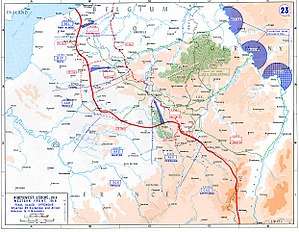
The French had suffered over 98,000 casualties and the British around 29,000. German losses were nearly as great if not slightly heavier. Duchêne was recalled by French Commander-in-Chief Philippe Pétain for his poor handling of the British and French troops but on a positive note the Americans had arrived and proven themselves in combat for the first time in the war. During the Second Battle of the Marne, the last fight on the Chemin des Dames occurred between 2 August and 10 October 1918 and the Germans finally abandoned the ridge and were pushed northwards.[14]
Cemeteries in the Chemin des Dames area
| Cemeteries in the Chemin des Dames area |
|---|
| A large number of soldiers (mostly French and German) were killed in the area during the four years of war, and there are many military cemeteries. During the 1920s, French graves which were scattered throughout the area were moved into 14 national military cemeteries. In some cases these cemeteries have also absorbed British or Russian casualties, and as only half of the dead could be identified many were laid to rest in ossuaries. Some of the cemeteries at Chemin des Dames hold the bodies of men killed at Soissons or in the Battle of the Marne; conversely the French military cemetery of Maison Bleue (in Cornicy, Marne) shelters some combatants who had fallen on the Chemin des Dames, particular in the area of Berry-au-Bac.
The 14 French Military cemeteries located in the Chemin des Dames area are:
There are 9 German cemeteries in the area. Some of these cemeteries were laid out by the German Army during the war (Veslud, Laon-Bousson and Montaigu in particular) and the others were built by the French authorities in the beginning of the 1920s in accordance with the Treaty of Versailles, which had stated that the victorious countries had the exclusive right to organise the German graves. Bodies in individual graves scattered around the area were concentrated into these 9 cemeteries. In 1966, management and care of the cemeteries was passed to the "Service d'Entretien des Sépultures militaries", the French subsidiary of the German Volksbund Deutsche Krieggräberfürsorge. These cemeteries are:
There are 5 British military cemeteries in the Chemin des Dames area, although many British graves remain within Chemin des Dames communal cemeteries, and some of the British dead from the Chemin des Dames are buried in Grand-Seraucourt British military cemetery, near St-Quentin, and in Montcornet British cemetery. The graves of many British and Irish soldiers can also be found in French military cemeteries, in particular in Vauxbuin French military cemetery, Berry-au-Bac military cemetery and in Crouy French military cemetery, The British Cemeteries are:
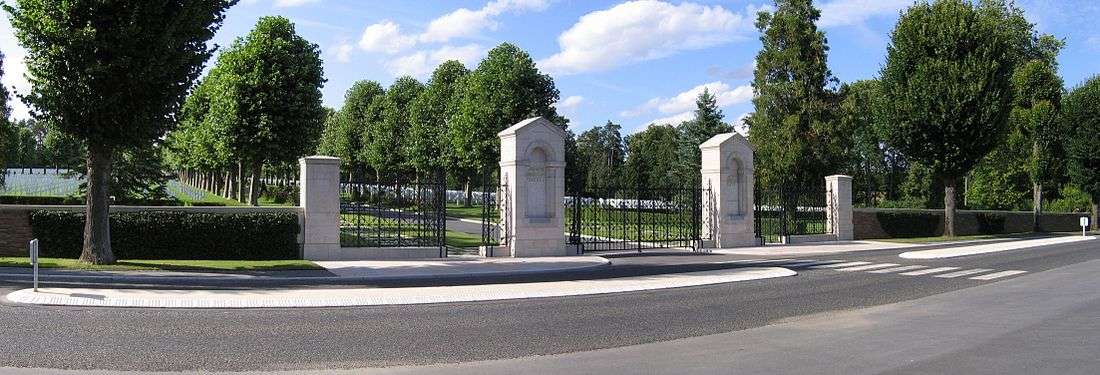 Seringes-et-Nesles Oise-Aisne American Cemetery entrance There is also a Danish cemetery at Braine, near the French military cemetery, which contains the graves of 79 Danish soldiers. They were from Schleswig, a territory annexed by Prussia in 1886, and had no choice but to serve in the German ranks. To commemorate their loss, a monument designed by Danish architect Gundlach-Petersen was unveiled in the cemetery on 7 May 1934.[44] |
Le Calvaire de l'Ange Gardien
| The "Guardian Angel" Calvary /"Le Calvaire de l'Ange Gardien" |
|---|
At the crossroads of the N2 and the D18 between Laon and Soissons, there is a calvary (Crucifixion sculpture), Le Calvaire de l'Ange Gardien (The Guardian Angel Calvary), dedicated to those soldiers who fought on the Chemin des Dames and in the Battle of La Malmaison. The inscription on the calvary reads:
There is also a plaque on the calvary dedicated to those who served in the 165th and 365th French Infantry as well as plaques remembering Claudius Champromis and Lieutenant René de Wismes. [45] |
The Monument to the Missing on the California Plateau
| The Monument to the Missing on the California Plateau |
|---|
| This monument is located at Craonne and pays tribute to all who fell in the Chemin des Dames between 1914 and 1918 but have no known graves. The bronze sculpture is nearly 4 metres (13 ft) in height and was designed by Haim Kern. It was unveiled on 5 November 1998 by the French First Minister Lionel Jospin accompanied by the Minister of Culture and Communication and the State Secretary to War Veterans. This work is entitled Ils n'ont pas choisi leur sépulture (English: they didn't choose their grave). Kern's composition is enigmatic and presents what appears to be metal netting in which the faces of soldiers appear at intervals. They appear trapped in the meshing and unable to escape – they are, as it were, caught in a situation that has resulted in their death but they are lost, as their remains were lost, and could not be found.[46] |
Monument for the Régiment d'infanterie coloniale du Maroc (RICM)
| Monument for the RICM – The Moroccan Colonial Infantry |
|---|
This monument stands in the Chemin des Dames area between the Malmaison farm and the Malmaison Fort, and was inaugurated on 8 July 1934. The inscription tells of the efforts made by the Régiment d'infanterie coloniale du Maroc (RICM) (English: Moroccan colonial infantry regiment) on 23 October 1917, when they took the quarries at La Bohéry on the southern slope of the ridge. Under the command of Lt Colonel Debailleul they successfully fought the Prussian Guard, taking 950 prisoners and capturing 10 German guns.
[47] |
Monument commemorating Captain Joost van Vollenhoven, RICM
| Monument commemorating Captain Joost van Vollenhoven, RICM |
|---|
| This monument celebrates RICM Captain Joost van Vollenhoven, who was killed in the nearby village of Pharmacy in 1918. The monument depicts Van Vollenhoven leading his men for the last time, and scenes from his previous service in the colonies of Africa and Indochina. Citations to both the Regiment and Van Vollenhoven adorn the sides of the monument. Like some of the other monuments in the area, it was restored following damage by the German occupiers during World War II.[48] |
"Constellation de la Douleur" – dedicated to the Tirailleurs "Sénégalais"
| "Constellation de la Douleur" – Dedicated to the Tirailleurs "Sénégalais" |
|---|
| Near the Caverne du Dragon is this tribute to the soldiers of Sénégal who served on the Chemin des Dames. It was commissioned as part of the celebrations marking the 90th anniversary of the end of World War I. It is the work of Christian Lapie and is composed of nine wooden figures. The inauguration took place on 22 September 2007.[49] |
Monument to the 31st French Infantry Regiment
| Monument to the 31st French Infantry Regiment |
|---|
This monument is located in the Pontavert National Cemetery and is dedicated to the 31st Infantry and in particular to those who fell in the assault of the "Bois des Buttes" and Ville-aux-Bois on 16–18 April 1917 during the Nivelle Offensive.
The inscription reads:
|
The Basque Memorial
| The Basque Memorial |
|---|
| The Basque Memorial, unveiled 30 September 1928, commemorates the people of the Basque Country who lost their lives on the Chemin des Dames. Both the architect Forest and the sculptor Claude Grange were veterans who had been wounded in the war. The stone used is from Souppes-sur-Loing.[51] At the base of an obelisk, 14 metres (46 ft) high, laurel wreaths bear the names of the administrative areas from which soldiers of the 36th Infantry Division came, and the sides bear the division's monogram. A Basque stands at the foot of the obelisk in traditional clothing, wearing the Basque béret, and looks towards the Aisne Valley.[52] |
Images of Basque Memorial
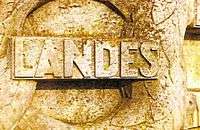 "Landes" mention on Basque Memorial.
"Landes" mention on Basque Memorial.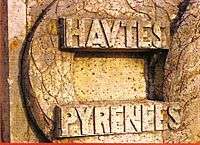 "Hautes Pyrenees" mention on Basque Memorial
"Hautes Pyrenees" mention on Basque Memorial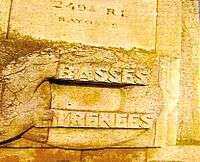 "Basses Pyrenees" mention on Basque Memorial
"Basses Pyrenees" mention on Basque Memorial
Memorial to the 2nd Colonial Corps
| Memorial to the 2nd Colonial Corps |
|---|
| This private memorial stands between Cerny and the d'Hurtebise farm, commissioned by the parents of 2nd Lieutenant Louis Astoul, who died along with many others of the 2nd Colonial Corps, assaulting the heavily defended German positions as part of the Nivelle offensive.[53] |
Memorial to the 36th French Infantry Division at the Fort de la Malmaison
| Memorial to the 36th French Infantry Division at the Fort de la Malmaison |
|---|
At the site of the Fort of Malmaison there is a memorial which remembers the actions of the 36th Infantry in the Battle of Malmaison on 23 October 1917
|
Tank Memorial at Berry-Au-Bac
| Mémorial des Chars d'Assaut at Berry-Au-Bac |
|---|
| The Tank Memorial (Mémorial des Chars d'Assaut ) pays tribute to all those tank drivers who fell in the course of 1917–1918. The work of Maxime Real del Sarte, it was erected following the efforts of a group of ex-infantrymen, and inaugurated on 2 July 1922 in the presence of Marshals Foch and Pétain and Generals Mangin and Weygand, as well as General Estienne, called Père des Chars ("father of the tank"). The monument is located at Choléra Farm, Berry-au-Bac, from where a mass attack of French tanks was thrown in the direction of Juvincourt on 16 April 1917. A plaque to the rear of the memorial recalls that on 16 April 1917, the 151st Infantry Regiment continued to advance with the assistance of Bossut's tanks right up to Béliers Wood. Tanks dating back to the 1950s are on display near the memorial.[55]
Tank Memorial at Berry-Au-Bac. In front of this memorial is a further memorial dedicated to General Estienne |
The Calvary at Choléra
| The Calvary at Choléra |
|---|
| The Calvary in front of the Tank Memorial at Berry-au-Bac indicates the spot where the first attack was made by French tanks and also remembers all who fell on the Chemin des Dames. There was a farm at this spot called "La Ferme du Choléra".[56] |
Monument to the aviators Vernes and Peinaud
| Monument to the aviators Vernes and Peinaud |
|---|
This monument, situated between Vailly-sur-Aisne and Ostel, was erected in 1921 by the Vernes family to remember Lieutenant-aviator Marcel Vernes and Sergeant-pilot Jean Peinaud who were killed in aerial combat on 24 March 1917. There are quotations attached to the monument from the Old and New testaments:
English: They fly like eagles. They run and never grow tired (Isaiah). They walk and don't tire themselves. Let each of you put at the others' disposal the gift you have received (Peter 4:20).[57] |
The Chapel at Cerny-en-Laonnois
| The Chapel at Cerny-en-Laonnois |
|---|
| The chapel at Cerny-en-Laonnois has become the main memorial to those who died on the Chemin des Dames and inside are numerous plaques dedicated to units or individuals who had been killed in the area. It is intended as a place for reflection and spiritual refuge for all who visit the battlefield area. In front of the chapel is a white lighthouse and behind, two cemeteries, one French the other German. In front of the chapel is a plaque commemorating the deeds of the 38th Division.
On 8 July 1962, during a private visit to the German Cemetery, Chancellor Konrad Adenauer was met by President Charles de Gaulle in what became a precursor to the Franco-German Treaty of 1963.[58]  The Chapel at Cerny-en-Laonnois |
The Monument des Crapouillots
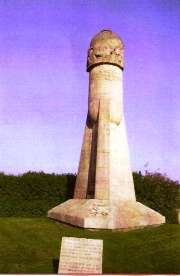
| The Monument des Crapouillots |
|---|
At the Moulin-de-Laffaux (hillock of Laffaux) is a monument dedicated to the 12,000 trench mortar operators (crapouillots) who fell in the region during World War I. The monument is shaped like the bomb fired by the trench mortar, and bears the inscription:
A plaque by the monument informs us that it was damaged in June 1940 during nearby fighting and repaired: [59] 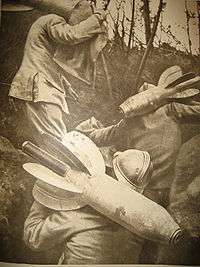 French soldiers handling trench mortar bombs |
Miscellaneous
The monument to the 11th Company of the 72nd Infantry Regiment
| The monument to the 11th Company of the 72nd Infantry Regiment |
|---|
| This monument is located at La Buisson, to the east of Vitry-le-François. It carries a quotation from Victor Hugo: "Ceux qui pieusement sont morts pour la patrie ont droit qu'à leur cercueil la foule vienne et prie."
The inscription refers to the fighting which took place on 6 September 1914.[60] |
Bridge to the 28th Infantry Division (US)
| 28th Infantry Division |
|---|
from the north |
Italian Cemetery at Bligny and the Italian volunteers who fought in France 1914–1915
| The Italian Cemetery at Bligny |
|---|
| Many Italians living in France joined the French army as volunteers, and on 5 November 1914, part of the Foreign Legion took the name "Régiment des Garibaldian" (after Giuseppe Garibaldi). These units were dissolved in 1915 when Italy officially joined the war, but in 1918 Italy sent 41,000 soldiers to fight in Champagne and the Chemin des Dames. From April to November 1918 they lost more than 9,000 men, many of whom are buried in the Bligny cemetery. Opposite the cemetery a "Roman Way" was established, lined with cypress trees and leading to a symbolic broken column.[61] |
Memorial to the 1st Loyal North Lancs at Vendresse, Troyon
| Memorial to the 1st Loyal North Lancs at Vendresse, Troyon |
|---|
| The 1st Battalion Loyal North Lancashire Regiment were part of 2nd Brigade, 1st Division, and commanded by Lieutenant Colonel G.C. Knight. The battalion's first action was alongside the 2nd Royal Sussex of the same Brigade, at Priez on 10 September 1914, when Lieutenant Colonel Knight was mortally wounded. Following the charge of 4th Dragoon Guards, the battalion crossed the Aisne at Bourg on 13 September and advanced towards the Chemin des Dames, halting at Vendresse. From here the battalion attacked Troyon on 14 September 1914, under the command of (Acting Lieutenant Colonel) Major W.R. LLoyd. In this action, the unit suffered heavy casualties, with nine officers being killed, five wounded and 500 other ranks killed or wounded. Among the dead was Lt-Col Lloyd, the second commanding officer to be killed since arrival in France.
The survivors dug-in on the slopes of the Chemin des Dames and held these positions until relieved by 1st East Yorks on 19 September 1914. The 1st Loyals remained on the Aisne until mid-October, when they were moved north to take part in the fighting in Flanders. They lost their third commanding officer, Major A.J. Carter DSO, at Ypres in November 1914. On the crest of the ridge at Troyon, the regiment erected a memorial to their dead. The inscription on it reads:Files held at the National Archives in Kew, covering the years 1919 to 1923, offers further background information on this memorial. C.T. Atkinson, who served on the committee whose approval was needed for memorials to be erected and to approve where they were to be located, wrote:
|
Cemeteries in Soupir
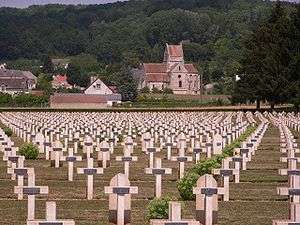
| Cemeteries in Soupir |
|---|
Located south of the Chemin des Dames, the village of Soupir was largely destroyed during the Second Battle of the Aisne. Five national cemeteries are now located in Soupir: two French, one German, one British and one Italian. The two French cemeteries are Soupir French Military Cemetery No. 1 and Soupir French Military Cemetery No. 2 and the German cemetery joins onto Soupir French Military Cemetery No. 2. There are 11,089 German soldiers buried there. 5,134 have their own graves (19 of them unknown soldiers – unbekannt ) while a further 5,995 are buried in the mass grave in the centre of the cemetery.
_nach_den_April-Angriffen_1917.jpg) Total devastation of Soupir in 1917 |
The Italian Cemetery at Soupir
| The Italian Cemetery at Soupir |
|---|
| This cemetery sits on the western outskirts of Soupir village on the D 925, between Vailly-sur-Aisne and Bourg-et-Comin. This area is known as Mont Sapin and was the subject of fierce fighting throughout the war. The 2nd Italian Army Corps arrived in France on 25 April 1918, as a sign of mutual aid from the Italian Government. Under the command of General Albricci, the Corps consisted of the 3rd and 8th Italian Divisions. They were initially positioned alongside French Divisions near Verdun in order to acclimatise themselves to conditions on the Western Front. Four months later, on 15 July 1918, the Germans attacked when the 2nd Battle of the Marne opened.
The Germans struck either side of Reims, in what was to be their last offensive of the war. The attack on the eastern side of Reims against General Gouraud's First Army came to a grinding halt on its first day. The western prong against Degoutte's Sixth Army made better progress and established some semblance of a breakthrough. Reinforcements from the French Ninth Army plus British, American, and the two Italian Divisions were all used to shore up the front. The German offensive was brought to a halt and then pushed back. On 20 July 1918, the Germans ordered a retreat and by 3 August 1918 they were back at their initial positions. Following their participation in this success, the 2nd Italian Corps was positioned on the river Aisne, just south of Soupir below the Chemin des Dames, on 22 September 1918. On 1 October, they took Soupir and spent the remainder of the month fighting along the Chemin des Dames as the Germans were slowly pushed north. During the course of the war, the 2nd Italian Corps lost 4,375 killed and 10,000 wounded. The cemetery at Soupir contains the bodies of 593 Italian soldiers, the majority of whom fell in fighting along the Chemin des Dames. From April to November 1918, the 2nd Italian Army Corps, made up of the 3rd and 8th Divisions (The Brescia and Alpi Infantry Brigades), fought in the Reims sector between Vrigny and Jaulgonne in the Ardennes sector, and in the Aisne to the east of Soissons, fighting under the 5th, 10th and the 3rd French Armies. The Italian forces commanded by General Alberico Albricci suffered more than 9,000 soldiers killed during its victorious campaigns. 592 of them rest in this Military Cemetery created and maintained by the Italian Ministry of Defence. The entrance to the cemetery at Soupir in shown here.[64] The Italian Cemetery at Soupir |
The Guards' Grave at Villers-Cotterêts
| The Guards' Grave at Villers-Cotterêts |
|---|
To the north and north-east of Villers-Cotterêts is the great Retz forest, through which the British Army I Corps were to march on 1 September 1914, and where three rearguard actions were fought. In one of these actions the 4th (Guards) Brigade, which included two platoons of Grenadiers, were covering the rear of the I Corps' 2nd Division and ran up against the German III Corps. They held the Germans for 4 hours, suffering many casualties. This action took place in an area known as the "Rond de la Reine", a clearing on the main road; it is marked by the Guards' Memorial and the graves of those who lost their lives are found nearby. The Guards' Grave originally made by the people of Villers-Cotterêts and was moved slightly to its present location by the Irish Guards in November 1914. It is a mass grave and contains the bodies of 98 guardsmen. A stone set in the ground states: "Here lie ninety-eight British soldiers".[65]
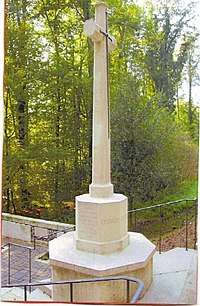 Guards Grave at Villers-Cotterêts |
The Monument to the United States First Division at Buzancy
| The Monument to the United States First Division at Buzancy |
|---|
This memorial commemorates the part played by the United States 1st Division at Soissons at the end of the Second Battle of the Marne. An obelisk is surmounted by an American eagle whose wings protectively envelop the 1st Division's crest. A bronze plaque recounts how the 1st Division advanced 11 kilometres (6.8 mi) into the German lines taking the village of Berzy-le-Sec and arriving just in front of Buzancy. The Division lost 2,213 men killed and 6,347 wounded from 18 to 21 July 1918, before being relieved by the 15th (Scottish) Division. The memorial to the Scots can be found in the nearby Buzancy Military Cemetery.[66]
 Memorial at Buzancy |
Monuments in and around Château-Thierry
Château-Thierry is a commune in northern France, about 90 kilometres (56 mi) east-northeast of Paris, a sub-prefecture of the Aisne department in Picardy. There are monuments and a cemetery to American Expeditionary Forces (AEF) which fought in this region in the summer of 1918, when they arrived to aid the Allies in the Second Battle of the Marne and the Hundred Days Offensive at the war's conclusion.
Château-Thierry American Monument
| Monument de la Côté 204 |
|---|
| This monument, also known as Monument de la Côté 204, commemorates "the sacrifices and achievements of American and French fighting men in the region, and the friendship and cooperation of French and American forces during World War I." It specifically remembers the joint action in the Battle of Château-Thierry, part of the Second Battle of the Marne, and other fighting in the area. Much of this fighting was to secure Hill 204 (Côté 204), 3 kilometres (2 mi) west of Château-Thierry.
Inaugurated in 1930, the monument was constructed by the American Battle Monuments Commission (ABMC), designed by architect Paul Philippe Cret with sculptures by Alfred-Alphonse Bottiau. It comprises a double colonnade standing on a long terrace, with two figures on the west face representing France and the United States. An enormous eagle and shield stand in front of the east face of the monument. The monument also includes a map showing the battle area.[67] |
The US Third Infantry Division Memorial at Château-Thierry
| The US Third Infantry Division Memorial at Château Thierry |
|---|
This memorial stands next to the river Marne, and commemorates the 3rd US Infantry Division's World War I casualties of 3,177 killed in action and 12,940 wounded. It first saw combat in the Second Battle of the Marne where it was called the "Rock of the Marne".[68]
 3rd Division memorial at Château-Thierry |
The Aisne-Marne American Cemetery

| The Aisne-Marne American Cemetery |
|---|
| The Aisne-Marne American Cemetery and Memorial is a 42-acre (17 ha) World War I cemetery in Belleau, at the foot of the hill where the Battle of Belleau Wood was fought. It was a temporary cemetery during the war (AEF Cemetery No. 1764-Belleau Wood), and was agreed to be retained as a permanent US WWI cemetery. The site is maintained by the ABMC, and its dedication ceremony was held on Memorial Day, 30 May 1937.
The Memorial Chapel is in the French Romanesque architecture style, with sculptural work by Alfred-Alphonse Bottiau on designs by William F. Ross and Company[69] (with memorial features designed by Cram and Ferguson). It was constructed on the site of front-line battle trenches. A crusader in armour is central in a relief on the tympanum above the chapel entrance, flanked by shields of the US and France intertwined with branches of oak, a symbol of unity between the two countries. Scenes from the trenches are carved on the columns to either side of the entrance. Above the inside door is the inscription: "The [1,060] names recorded on these walls are those of American soldiers who fought in this region and who sleep in unknown graves." On the belfry columns are 11 carvings representing various units involved in the war, which are repeated on each side of the chapel. The arches of the belfry openings carry additional carvings, of small arms ammunition and other objects of war. Below the belfry openings and on each side of the chapel are sculpted heads: a French soldier, a French nurse, a US aviator, a Scottish soldier, a Russian soldier, a Portuguese soldier, a Canadian aviator, and a British Women's Army Corps driver. The exterior steps, walls, and tartar are of native limestone.[70] |
Belleau Wood Memorial
| Belleau Wood and the Belleau Wood Memorial |
|---|
| In the centre of the road leading through Belleau Wood is a monument and flagpole; the monument bears a relief by Felix de Weldon depicting a US Marine. This marks the battle fought in Belleau Wood in June 1918, part of the Second Battle of the Marne. The US Army 2nd and 3rd Divisions (which included large numbers of marines) launched multiple attacks to take heavily defended German positions in the wood, taking casualties of 1,811 dead and 7,966 wounded.[71] |
The area to the east of Reims

| The area to the east of Reims |
|---|
| The area between Reims and the Forest of Argonne – 30 by 4 kilometres (19 by 2 mi) – saw fierce fighting over the four years of war. 103 different French Divisions were engaged along with 4 American Divisions and 2 Russian Brigades, as well as Polish and Czechoslovakian units. Seven villages in the area were so badly damaged that they were never rebuilt.
In the present French military camp of Moronvilliers, there is a small chapel commemorating the destroyed villages of Nauroy and Moronvilliers. Erected in 1920 and positioned on the site of Nauroy, the chapel has been restored by "L'Amicale des Diables bleus d'Épernay". Five ruined villages lie in the camps at Moronvillers, Mourmelon and Suippes, and the French Army allows public access in September of every second year, organising tours known as "La Journée des Villages Détruits". At Souhain there is a monument and ossuary dedicated to the French Foreign Legion.[72] |
The monument aux morts at Sillery
| The monument aux morts at Sillery |
|---|
| The monument aux morts at Sillery, inaugurated in 1925, features a sculpture by Édouard Sediey. It is composed of a distraught woman before a cross inscribed with the names of the dead and the words: "Sillery à ses morts glorieux 1914–18".
Near this memorial is another dedicated to the martyrs of the Resistance. It is a Cross of Lorraine (a symbol of French patriotism) upon which are carved the faces of three of those deported by the Germans and the names of 8 people who died while deported.[73]  Monument aux morts at Sillery |
Military cemeteries at Aubérive
| Military cemeteries at Aubérive |
|---|
| The French Military Cemetery at Aubérive holds the remains of 6,424 French soldiers. 2,908 could not be properly identified and their remains were placed in three ossuaries.[74]
Ossuary at Aubérive The Polish cemetery at Aubérive is situated southeast of Reims and is a part of the French cemetery at Le Bois du Puits. It contains the graves of 129 Polish soldiers killed in World War I (and 256 killed in World War II). Many of these volunteered for the French Foreign Legion. At the cemetery is a memorial to these 129 men, composed of an obelisk surmounted by a cross. There is also a monument to the 1st and 2nd divisions of Polish Infantry, formed in 1917 and known as the Blue Army.[75] The Polish monument in the Bois du Puits cemetery The German cemetery at Aubérive lies to the rear of the French cemetery at Le Bois du Puits. 5,359 German soldiers were buried here; 3,124 could not be identified and their bodies were laid in an ossuary. Many of the soldiers were Thüringian.  French and Germans fighting in an Aubérive trench. |
Monument to the 103rd French Infantry Regiment
| Monument to the 103rd French Infantry Regiment |
|---|
This memorial was erected by the French veterans organisation "Souvenir français" and is located in the village of Aubérive. The inscriptions include:
[76] There is also the monument Borne No. 77, one of the series created by Paul Moreau-Vauthier to mark the furthest points of German advance along the Western Front. Those bornes (stone markers) in France were made from pink granite from Andlau in Alsace. This borne bears the inscription: "Ici fut repoussé l’envahisseur Juillet 1918", corresponding to the liberation of Château-Thierry.[77] |
Memorial remembering the "Eugène" trench and the Monument to the 8th Army Corps
| Memorial remembering the "Eugène" trench |
|---|
The memorial to the "Eugène" trench, funded by Souvenir Français, and the 8th Army monument are located in the Val-de-Vesle, east of Reims in the direction of Sainte-Ménehould. The memorial is dedicated to those soldiers who were killed in the area in the offensives of April 1917. Nearby are Vauthier Bornes 36 and 37.
The inscription does not mince words:
Visitors are entreated to not forget the dead (translation): "They too loved life and gave their lives to ensure that there would be peace between all men! Passersby do not forget this!"[78] |
The Fort de la Pompelle and the defence of Reims
| The Fort de la Pompelle and the defence of Reims |
|---|
Souvenir Français organised this memorial at the Alger farm, 4 kilometres (2 mi) from Reims, where fighting took place to defend the Fort de la Pompelle. On it is inscribed "Aux héros de la Grande Guerre" (To the heroes of the Great War). The monument was restored in 1998 on the 80th anniversary of the armistice, and carries the inscription:
 Photograph showing the damage done to the Fort de la Pompelle after constant bombardment Monument in memory of the soldiers who were killed defending the Fort de la Pompelle |
La Croix Brisée de Confrécourt
| The Farm at Confrecourt |
|---|
Near the village of Confrécourt is the memorial known as "La croix brisée" (broken cross). It was commissioned and erected in 1929 by the owner of the farm at Confrecourt, and it bears his family crest. It was intended to symbolise the suffering of all Frenchmen who fought on the Confrecourt plateau in WWI and includes the words "La croix est tombée, le Christ est vivant". The farm and the many quarries and limestone caves in the area were to serve as living quarters for French troops during the war of the trenches.[80]
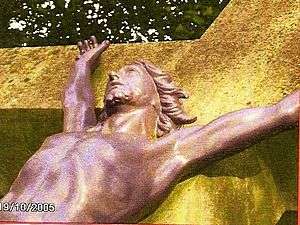 La croix brisée |
Monument to the African Soldiers who died 1914–1918
| Monument to the African Soldiers who died 1914–1918 |
|---|
| This monument stands at the junction of the Boulevard Giroud and the Rue Vasquier on the eastern side of Reims. The original monument was erected in July 1924, and was a copy of a monument in Bamako, capital of the French Sudan (now Mali). These twin monuments celebrated the memory of the indigenous African soldiers who had given their lives in the service of France. At the 29 October 1922 groundbreaking, André Maginot recalled the bravery of Sergeant Amadou Di'ale of the 34th Bataillon of Senegalese Tirailleurs; and at the 13 July 1924 inauguration, General Archinard mentioned in particular the contribution made by the 1st Corps of the Colonial Army in holding the Fort de la Pompelle against German attack that threatened Reims.
The monument itself was the work of two Parisiens: sculptor Paul Moreau-Vauthier and architect Auguste Bluysen. It comprised a pedestal 4 metres (13 ft) in height upon which were carved the names of the principal battles in which African troops participated. On top of the pedestal was a 3-metre (10 ft) bronze sculpture depicting a group of four soldiers of the colonial armies gathered around a white officer holding the French National flag. During WWII, German occupiers pulled the monument down and took it from Reims in a railway wagon, possibly to melt down the bronze for armaments. With the end of the Algerian war, thoughts turned to building a replacement and a competition was organised to choose a design. On 6 October 1963, the new monument was unveiled by Minister of War Pierre Messmer. It is modern in design and two columns in limestone represent the union of African and French soldiers and the block upon which these columns stand was intended to represent Reims' resistance in WWI. .jpg) The old Reims memorial to Black Soldiers  The new memorial in Reims to African soldiers who fought for France in 1914–1918 |
The Blanc Mont American Memorial at Sommepy-Tahure
| The Blanc Mont American Memorial at Sommepy Tahure |
|---|
The Sommepy Monument stands on the crest of Blanc Mont ridge, to the north of Sommepy-Tahure, and celebrates the 70,000 US soldiers who fought alongside the French in the Champagne region. Dedicated in 1937, it bears the insignias of the 93rd, 36th, 2nd and 42nd US Divisions and where they fought. The inscription reads:
The monument is in the form of a tower. Visible within, through the grill in the door, is a brief summary of US operations in the area. When open to visitors, it is possible to climb to an observation platform at the top of the tower.[81] 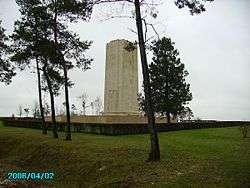 American Memorial at Sommepy Tahure |
French Military Cemetery at Sommepy-Tahure
| French Military Cemetery at Sommepy-Tahure |
|---|
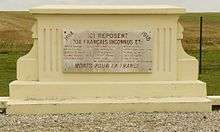 Ossuary at Sommepy-Tahure French Military Cemetery The French Military cemetery of Sommepy-Tahure contains the remains of 2,201 French soldiers, of whom 704 lie in an ossuary shown here. The cemetery was created in 1920 for bodies exhumed in the area east of Reims.[82] |
Monument to the 60th French Infantry Regiment at Ville-en-Tardenois
| Monument to the 60th French Infantry Regiment at Ville-en-Tardenois |
|---|
| This monument stands south-west of Reims on the RD 980, as one leaves Ville-en-Tardenois in the direction of Dormans.
The inscription reminds visitors that many men of the 60th French Infantry Regiment fell fighting in the woods of Courmont, Bonval and Cohette and the area around Ville-en-Tardenois in the attacks against the Germans from 26 July to 2 August 1918. |
Monument to the 5th and 6th American Marines at Sommepy-Tahure
| Monument to the 5th and 6th American Marines at Sommepy-Tahure |
|---|
| This monument to two regiments of the United States 2nd Division was erected at the foot of the hill on which the Church of Sommepy-Tahure stands. The inscription tells visitors that the 5th and 6th Regiments conquered the territory north of Sommepy and Blanc-Mont. |
The German Military Cemetery at Souain-Perthes-les-Hurlus
| The German Military Cemetery at Souain-Perthes-les-Hurlus |
|---|
| This cemetery lies in the area of Souain-Perthes-lès-Hurlus and is near the French Military Cemetery at "La Crouée". The cemetery holds the remains of 13,786 soldiers. 11,322 bodies could not be identified and were placed in an ossuary. |
The Ferme de Navarin Monument
| The monument at the farm of Navarin |
|---|
| Situated 45 kilometres (28 mi) east of Reims, "Le Monument aux morts des Armées de Champagne" was inaugurated in 1924 by General Gouraud, the Military Governor of Paris who commanded the 4th French army in Champagne in 1916 and from June 1917 until November 1918. The monument is privately maintained by the organisation "Monument aux morts des Armées de Champagne et Ossuaire de Navarin".
Near to the village of Souhain is a Celtic cross marking the memorial to the French 28th Infantry Brigade and also the imposing monument of the "Ferme de Navarin". It is a combined monument and ossuary, within which lie the remains of 10,000 soldiers who fell on the plains of Champagne. The monument is a pyramid-like structure surmounted by a sculpture by Maxime Real del Sarte of three soldiers. The middle figure is meant to portray Gouraud; the soldier on the right represents Quentin Roosevelt who was killed in Cambrai on 14 July 1918; and the figure on the left represents del Sarte's brother who was killed in Champagne. At the base of the monument are listed the numerous divisions who fought in Champagne. Among the 10,000 soldiers in the crypt are the four sons of Paul Doumer. When General Gouraud died in 1946, he had asked to be buried with his men in the "Ferme de Navarin" and his tomb has pride of place in the crypt.[83] 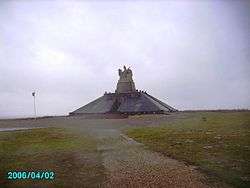 Ferme de Navarin War Memorial 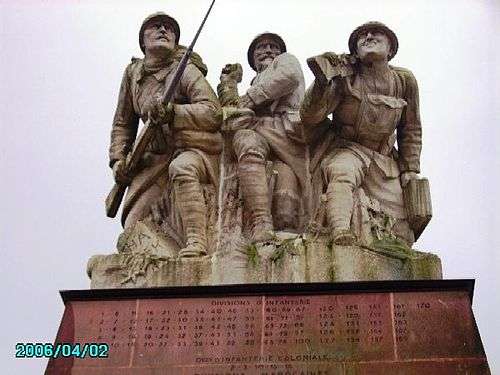 Ferme de Navarin |
Russian Chapel and Cemetery at Saint-Hilaire-le-Grand
| Russian Chapel and Cemetery at Saint-Hilaire-le-Grand |
|---|
| The cemetery is located in an area known as "L'Espérance", near the French military camp at Mourmelon, and was erected in memory of 4,000 Russian Expeditionary Force (REF) soldiers killed on the battlefields of Champagne fighting alongside the French and British armies. Their brigades occupied the Fort de la Pompelle near Reims and sustained heavy losses in the Nivelle offensive. Disbanded when the Russian Revolution broke out in October 1917, the officers, with some volunteers from the ranks, formed a "Légion russe d'honneur" and continued to fight until the end of the war, wearing French uniforms and being absorbed into the Moroccan Regiment.
In honour of their fallen, the survivors opened this Russian cemetery and later added a chapel, built in the Russian Orthodox style. The cemetery contains the bodies of 915 Russian soldiers either buried in ossuaries or individual graves (included in the gallery at the end of this article is a picture of a typical headstone and the marker for one of the ossuaries in the cemetery).[84]  Plaque in the Russian Cemetery at Saint-Hilaire-le-Grand acknowledging the efforts of the Russian Expeditionary Force  Chapel in Russian Cemetery at Saint-Hilaire-le-Grand |
The Cemetery at "Wacques Farm" and the 28th Brigade Memorial
| Nécropole nationale de Souain – 28e Brigade |
|---|
| This small French Military Cemetery is located near Châlons-en-Champagne and Saint-Hilaire-le-Grand, and is the burial place of 147 French soldiers. The monument to the 28th Brigade stands on a hill in the cemetery facing the Wacques Farm. This memorial consists of a large cross or calvary, which carries the inscription "Aux morts de la XXVIIIe Brigade" and is surrounded in a circle by many smaller crosses.
From 25 to 30 September 1915, the 28th Brigade fought in this area and lost 1,133 men including 39 officers. After the war, the chaplain of the 28th Brigade and several volunteers returned to the battlefield to locate and bury the rest of their comrades, and the monument and cemetery were inaugurated on 25 September 1919. This cemetery is officially named the "Nécropole nationale de Souain – 28e Brigade". There is a smaller memorial next to the "Wacques Cross" dedicated to the men of the 44th Infantry, which carries the inscription: "Aux camarades tombés pendant les journées du 25-26-27-28-29 Septembre 1915. Etat-Major". Nearby, a memorial to the 60th Infantry is inscribed: "Aux morts du 60e RI Attaques des 25 au 29 - 09 - 1915"[85] |
The monument to the four corporals shot at Souain in 1915
| The monument to the four corporals shot at Souain in 1915 |
|---|
| In March 1915, four corporals of the 21st Company of the 336th Regiment of Infantry – Louis Girard, Lucien Lechat, Louis Lefoulon et Théophile Maupas – were tried for mutiny and executed by firing squad. In his last letter to his wife, Maupas wrote "Je n'ai rien à me reprocher, je n'ai ni volé, ni tué, je n'ai sali ni la réputation ni l'honneur de personne. Je puis marcher la tête haute". The four soldiers had been selected randomly to be made examples of, when there had been a general refusal to obey a 10 March order to leave the trenches and attack the enemy.
For many years, Maupas' wife, Blanche Maupas, and others fought to have the men pardoned. In 1923, Blanche succeeded in having her husband's remains taken from the grave in Suippes and moved to the communal cemetery of Sartilly in La Manche. In 1925, a monument by Paul Moreau-Vauthier was erected over Maupas' grave at Sartilly, commemorating the four corporals of Souhain. In 1934, the four corporals were given a formal pardon by a special tribunal which came to the conclusion that the order they received was unreasonable. The Souain corporals affair was considered most controversial in France; the 1957 Stanley Kubrick film Paths of Glory, based on the events at Souhain, was banned in France until 1975 and was not shown on television until 1982. In 1962, Blanche Maupas died and was buried alongside her husband. A monument honouring the four corporals stands in Suippes, facing the town hall where the military tribunal sentenced them to execution. It was inaugurated on 1 December 2007, with the inscription reading: "À la mémoire des caporaux de Souain Theophile Maupas, Louis Girard, Lucien Lechat et Louis Lefoulon Fusillés pour l'exemple, à Suippes, le 17 mars 1915".[86]  Memorial to four corporals executed at Suippes |
The Memorial at Montagne de Bligny
| The Memorial at Montagne de Bligny |
|---|
| This memorial to commemorates the actions of the 19th Division of the British Army. File WO 32/5885, held at The National Archives, covers the memorial at Montagne de Bligny near Reims. In the file is a photograph of the memorial, which takes the form of a simple cross. |
German Cemetery at Saint-Étienne-à-Arnes
| German Cemetery at Saint-Étienne-à-Arnes |
|---|
Saint-Étienne-à-Arnes has a large German Military Cemetery which contains 12,541 bodies and a rare surviving German monument which is shown here. The inscription "GOTT MIT UNS" is a reminder that the German soldier also thought that God was on his side. An ossuary contains the remains of unidentified German soldiers and quotes from 2 Corinthians 6:9 "..the unknown men whom all men know; dying we still live on".
 Plaque over ossuary in Saint-Étienne-à-Arnes quotes 2 Corinthians 6:9.  A German monument bearing the legend "Gott mit uns" |
Gallery
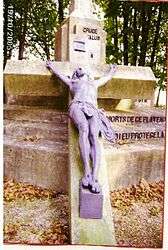 Memorial at Confrecourt
Memorial at Confrecourt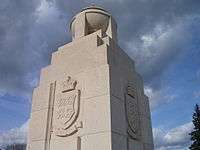 Part of the La Ferté-sous-Jouarre memorial
Part of the La Ferté-sous-Jouarre memorial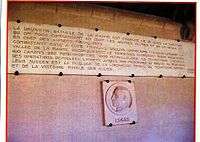 Foch depicted at Dormans on plaque which includes a description of the Second Battle of the Marne.
Foch depicted at Dormans on plaque which includes a description of the Second Battle of the Marne.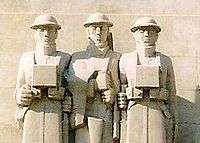 Kennington's sculpture at Soisson's "Memorial to the Missing"
Kennington's sculpture at Soisson's "Memorial to the Missing"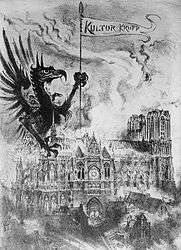 French Cartoon of Reims Cathedral bombarded by the German Army during World War I
French Cartoon of Reims Cathedral bombarded by the German Army during World War I Poster showing Reims Cathedral asks French Canadians to enrol.
Poster showing Reims Cathedral asks French Canadians to enrol.- German graves at Aubérive
 Russian soldiers in France
Russian soldiers in France Sculpture on Ferme de Navarin monument
Sculpture on Ferme de Navarin monument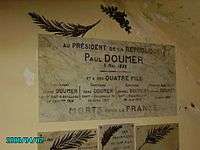 Plaque remembering the four sons of the French president at the Ferme de Navarin
Plaque remembering the four sons of the French president at the Ferme de Navarin Ossuary in the Russian Cemetery at Saint-Hilaire-le-Grand
Ossuary in the Russian Cemetery at Saint-Hilaire-le-Grand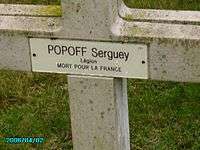 Russian headstone in the cemetery at Saint-Hilaire-le-Grand
Russian headstone in the cemetery at Saint-Hilaire-le-Grand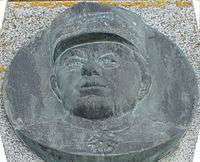 Relief of Jean-Baptiste Estienne at the Tank Memorial, Berry-Au-Bac
Relief of Jean-Baptiste Estienne at the Tank Memorial, Berry-Au-Bac Joffre depicted at Dormans
Joffre depicted at Dormans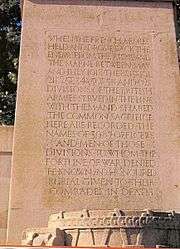 Inscription on Soissons Memorial to the Missing
Inscription on Soissons Memorial to the Missing Eric Kennington's sculptural work on the Soissons Memorial to the Missing
Eric Kennington's sculptural work on the Soissons Memorial to the Missing Royal Engineers Memorial at La Ferté-sous-Jouarre
Royal Engineers Memorial at La Ferté-sous-Jouarre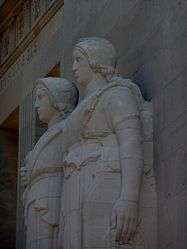 The Chateau Thierry Monument
The Chateau Thierry Monument
See also
- World War I memorials
- Monuments aux Morts – greater detail on French war memorials
- List of World War I Memorials and Cemeteries in Alsace
- List of World War I memorials and cemeteries in the Argonne
- List of World War I memorials and cemeteries in Artois
- List of World War I memorials and cemeteries in Champagne-Ardennes
- List of World War I memorials and cemeteries in Flanders
- List of World War I Memorials and Cemeteries in Lorraine
- List of World War I memorials and cemeteries in the Somme
- List of World War I memorials and cemeteries in Verdun
- List of World War I memorials and cemeteries in the area of the St Mihiel salient
- War memorials (Aisne)
- War memorials (Oise)
- War memorials (Eastern Somme)
- War memorials (Western Somme)
References
- ↑ Memorial to the First Battle of the Marne at Mondemont Association Mondement 1914. Comprehensive website on Mondement (in French but Google translation facility can be used). Retrieved 20 January 2013
- ↑ Dormans Memorial Le Mémorial des batailles de la Marne. Retrieved 20 January 2013
- ↑ Butte de Chalmont Archived 12 April 2013 at Archive.is WW1 Memorials. Retrieved 11 February 2013
- ↑ https://web.archive.org/web/20070927012005/http://www.la-ferte-sous-jouarre.fr/commune/htm/histoire2.htm. Archived from the original on 27 September 2007. Retrieved 7 February 2013. Missing or empty
|title=(help) - ↑ La Ferté-sous-Jouarre memorial Commonwealth War Graves Commission. Retrieved 19 January 2013
- ↑ La Ferté-sous-Jouarre memorial Commonwealth War Graves Commission. Retrieved 11 February 2013
- ↑ Memorial to the Missing at Soissons Commonwealth War Graves Commission. Retrieved 20 January 2013
- ↑ Monument aux Morts Reims www.memorial-genweb.org. Retrieved 21 January 2013
- ↑ Monument hommage aux infirmières Reims Les mémoriaux, mausolées, monuments, stèles et plaques commémoratives de la 1ère guerre mondiale dans la Marne. Retrieved 21 January 2013
- ↑ Monument to the 132nd French Infantry Regiment CNDP Reims. Retrieved 27 January 2013
- ↑ Monuments to the 24th, 28th, 133rd and 363th French Infantry Regiments CRDP Reims. Retrieved 24 January 2013
- ↑ The German Cemetery at Loivre CRDP Reims. Retrieved 24 January 2013
- ↑ 119th Infantry CNDP Reims. Retrieved 27 January 2013
- ↑ Chemin des Dames www.memorial-chemindesdames.fr. Retrieved 11 February 2013
- ↑ Berry-au-Bac French Cemetery Chemin des Dames. Retrieved 27 January 2013
- ↑ Calvary Cholera Picardie 1418. Retrieved 26 January 2013
- ↑ Braine French Cemetery Chemin des Dames. Retrieved 27 January 2013
- ↑ Cerny-en-Laonnois French national cemetery Chemin des Dames. Retrieved 27 January 2013
- ↑ Craonnelle French national cemetery Chemin des Dames. Retrieved 27 January 2013
- ↑ Crouy French national cemetery Chemin des Dames. Retrieved 27 January 2013
- ↑ Oeuilly French national cemetery Chemin des Dames. Retrieved 27 January 2013
- ↑ Pontavert French National cemetery Chemin des Dames. Retrieved 27 January 2013
- ↑ Soupir n°1 French national cemetery Chemin des Dames. Retrieved 27 January 2013
- ↑ Soupir n°2 French national cemetery Chemin des Dames. Retrieved 27 January 2013
- ↑ Vailly-sur-Aisne French national cemetery Chemin des Dames. Retrieved 27 January 2013
- ↑ Vauxaillon French national cemetery Chemin des Dames. Retrieved 27 January 2013
- ↑ Vauxbuin French national cemetery Chemin des Dames. Retrieved 27 January 2013
- ↑ Cerny-en-Laonnois German cemetery Chemin des Dames. Retrieved 27 January 2013
- ↑ Laon-Bousson German cemetery Chemin des Dames. Retrieved 27 January 2013
- ↑ Montaigu n°1 German cemetery Chemin des Dames. Retrieved 27 January 2013
- ↑ Montaigu n°2 German cemetery Chemin des Dames. Retrieved 27 January 2013
- ↑ Mons-en-Laonnois German cemetery Chemin des Dames. Retrieved 27 January 2013
- ↑ Soupir German cemetery Chemin des Dames. Retrieved 27 January 2013
- ↑ Sisonne German cemetery Chemin des Dames. Retrieved 27 January 2013
- ↑ Veslud German cemetery Chemin des Dames. Retrieved 27 January 2013
- ↑ Vauxbuin German Cemetery Chemin des Dames. Retrieved 27 January 2013
- ↑ Grand-Seraucourt British cemetery Chemin des Dames. Retrieved 27 January 2013
- ↑ La Ville-aux-Bois-les-Pontavert British cemetery Chemin des Dames. Retrieved 27 January 2013
- ↑ Montcornet Cemetery Chemin des Dames. Retrieved 27 January 2013
- ↑ Sissonne British Cemetery Chemin des Dames. Retrieved 27 January 2013
- ↑ Soupir British cemetery Chemin des Dames. Retrieved 27 January 2013
- ↑ Vendresse British cemetery Chemin des Dames. Retrieved 27 January 2013
- ↑ Vailly-sur-Aisne British Cemetery Chemin des Dames. Retrieved 27 January 2013
- ↑ Cemeteries on the Chemin des Dames Chemin des Dames. Retrieved 26 January 2013
- ↑ Le Calvaire de l'Ange Gardien Chemin des Dames. Retrieved 26 January 2013
- ↑ Monument on California Plateau Chemin des Dames. Retrieved 26 January 2013
- ↑ Monument to the Moroccan Infantry Chemin des Dames. Retrieved 26 January 2013
- ↑ Joost van Vollenhoven www.webmatters.net. Retrieved 28 January 2013
- ↑ Constellation de la Douleur Chemin des Dames. Retrieved 27 January 2013
- ↑ Monument to the 31st French Infantry Chemin des Dames. Retrieved 27 January 2013
- ↑ The Basque Memorial Archived 14 November 2008 at the Wayback Machine. www.racines-en-sevignac.fr. Retrieved 20 January 2013
- ↑ Basque Monument Chemin des Dames. Retrieved 11 February 2013
- ↑ Memorial to the 2nd Colonial Corps www.webmatters.net. Retrieved 11 February 2013
- ↑ caverne-du-dragon Archived 5 March 2016 at the Wayback Machine. Chemin des Dames. Retrieved 11 February 2013
- ↑ Tank Memorial at Berry-Au-Bac Picardie 14–18. Retrieved 26 January 2013
- ↑ Calvary at Choléra Chemin des Dames. Retrieved 26 January 2013
- ↑ Monument to the aviators Vernes and Peinaud Chemin des Dames. Retrieved 26 January 2013
- ↑ The Chapel at Cerny-en-Laonnois www.webmatters.net. Retrieved 25 January 2013
- ↑ The Monument des Crapouillots www.memorial-chemindesdames.fr. Retrieved 24 January 2013
- ↑ Monument to the 72nd Infantry CRDP Reims. Retrieved 27 January 2013
- ↑ www.champagne-ardenne-tourism.co.uk. Retrieved 28 January 2013
- ↑ Memorial to the 1st Loyal North Lancs at Vendresse, Troyon Battlefields 1418. Retrieved 20 January 2013
- ↑ Memorial to the 1st Loyal North Lancs at Vendresse, Troyon Commonwealth War Graves Commission. Retrieved 19 January 2013
- ↑ Italian Cemetery at Soupir www.webmatters.net/france. Retrieved 20 January 2013
- ↑ The Guards' Grave at Villers-Cotterêts Archived 20 July 2013 at the Wayback Machine. WW1 Cemeteries. Retrieved 19 January 2013
- ↑ The Monument to the United States First Division at Buzancy www.webmatters.net. Retrieved 11 February 2013
- ↑ Château-Thierry American Monument Archived 19 November 2010 at the Wayback Machine. American Battle Monuments Commission. Retrieved 18 January 2013
- ↑ Memorial to 3rd Division Archived 8 December 2013 at the Wayback Machine. WW1 Memorials. Retrieved 18 January 2013
- ↑ (PDF) https://web.archive.org/web/20120207002513/http://www.abmc.gov/cemeteries/cemeteries/am_base.pdf. Archived from the original (PDF) on 7 February 2012. Retrieved 7 February 2013. Missing or empty
|title=(help) - ↑ The Aisne-Marne American Cemetery Archived 8 December 2013 at the Wayback Machine. WW1 Memorials. Retrieved 18 January 2013
- ↑ Belleau Wood www.historylearningsite.co.uk. Retrieved 18 January 2013
- ↑ The destroyed villages of the region east of Reims CRDP de Champagne-Ardenne. Retrieved 24 January 2013
- ↑ The monument aux morts at Sillery CRDP Reims. Retrieved 11 February 2013
- ↑ French Military Cemetery at Aubérive crdp-reims. Retrieved 24 January 2013
- ↑ Polish Cemetery at Aubérive www.polishwargraves.nl. Retrieved 24 January 2013
- ↑ Le Monument aux morts du 103e Régiment d'infanterie Les mémoriaux, mausolées, monuments, stèles et plaques commémoratives de la 1ère guerre mondiale dans la Marne. Retrieved 21 January 2013
- ↑ Monument to the 103rd French Infantry Regiment and "Borne no.77. Retrieved 23 January
- ↑ Memorial remembering the "Eugene" trench and the Monument to the 8th Army Corps CXRDP de Champagne-Ardenne. Retrieved 24 January 2013
- ↑ Fort de la Pompelle CRDP de Champagne-Ardenne. Retrieved 24 January 2013
- ↑ The Farm at Confrecourt Picardie 1418. Retrieved 25 January 2013
- ↑ The Sommepy Tahure American Monument CRDP Reims. Retrieved 25 January 2013
- ↑ French Military Cemetery at Sommepy-Tahure CRDP de Champagne-Ardenne. Retrieved 22 January 2013
- ↑ Ferme de Navarin CRDP Reims. Retrieved 11 February 2013
- ↑ Russian Chapel and Cemetery at Saint-Hilaire-le-Grand CRDP de Champagne-Ardenne. Retrieved 21 January 2013
- ↑ The Cemetery at "Wacques Farm" and the 28th Brigade Memorial CRDP Reims. Retrieved 25 January 2013
- ↑ The monument to the four corporals shot at Souain in 1915 Archived 20 August 2008 at the Wayback Machine. Hellfire-Corner. Retrieved 25 January 2013